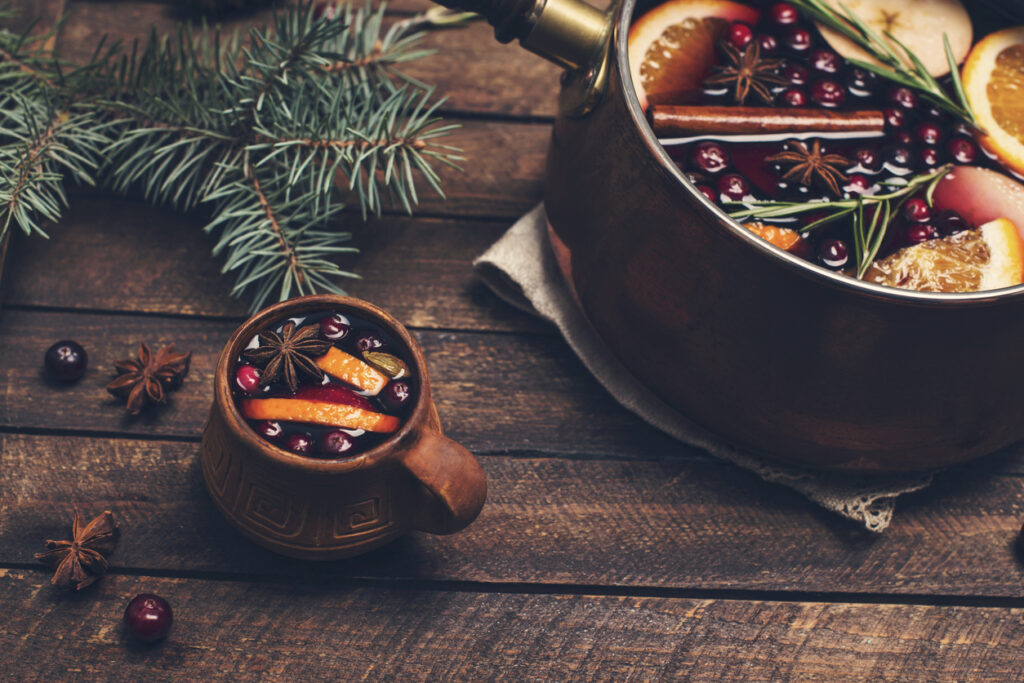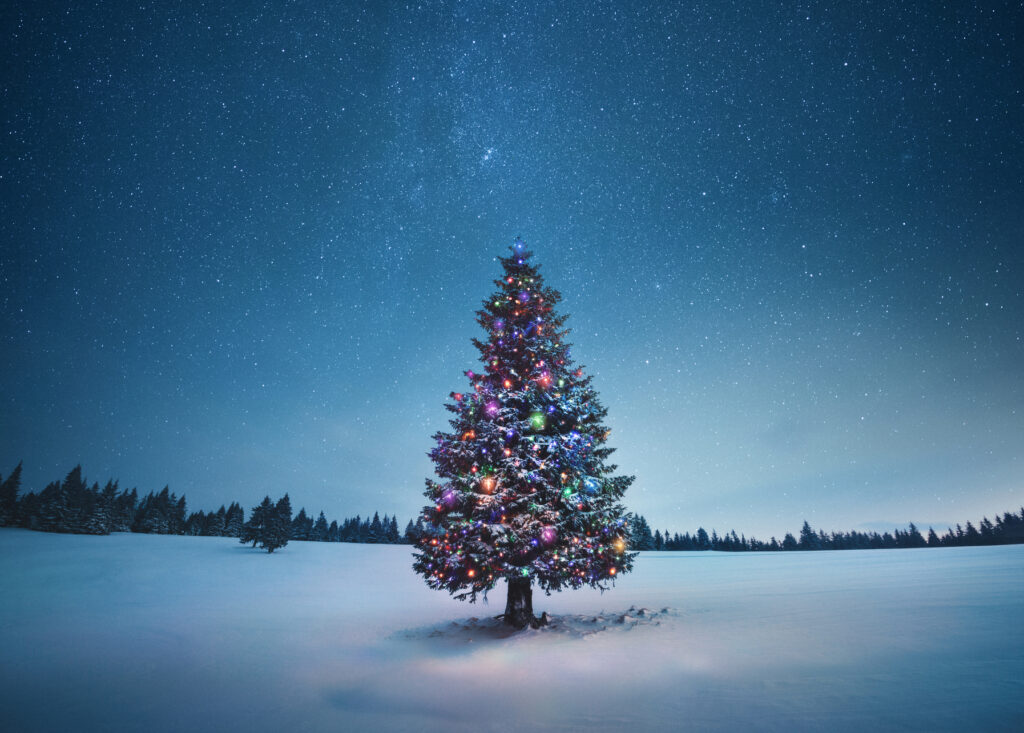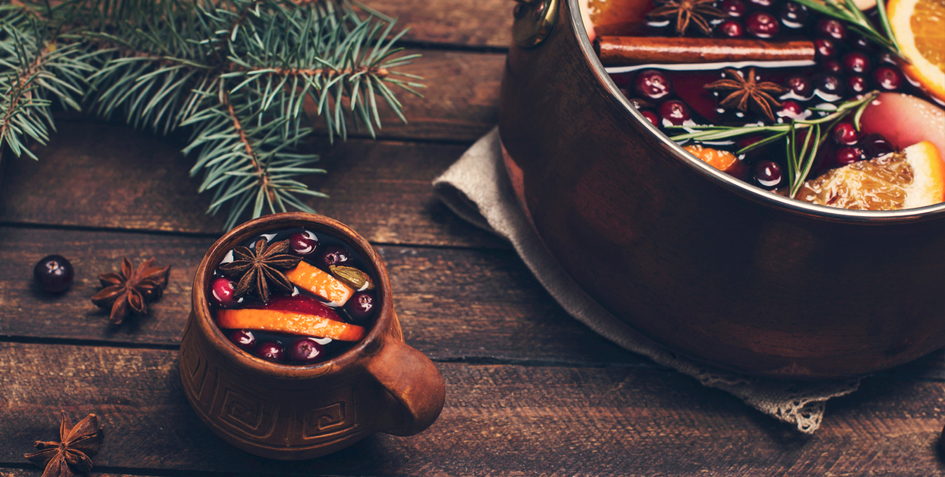
Fresh cut Pine and Spruce trees, Cedar boughs, pots of evergreen needles steaming on the wood stove. Aromas of Cinnamon and Clove rising from the oven. Orange peel and Star Anise filling your senses as you sip spiced apple cider from your mug. Mulled wine. Who doesn’t love the aromas of the holidays?
There are many scents that bring us joy, warmth, comfort, and the memories of holiday seasons past. But where did all of these wintertime plant traditions come from and what was their original purpose?
The chances are good that your ancestors from long ago once held on to customs like these as beacons of hope around the time of the winter solstice, uniting the family and even keeping them in good health. Our ancient ancestors didn’t have the luxury of central heating and running hot water like so many of us do today.
Life was even scary at times in the winter months in some parts of the world, and survival was uncertain, with no promise of seeing the next spring. Evergreen plants kept people strong-willed, hopeful, connected to something sacred, and even helped strengthen their immunity during these times.
Origins of the Christmas Tree
For thousands of years, before the plastic Christmas tree was invented, many traditional peoples were close to nature in a spiritual and practical way. Trees of all kinds were honored, respected, and even worshiped in countless cultures, and still are today. My Scandinavian ancestors of northern Norway for instance, had a deep spiritual connection to trees like Pine, Fir, and Spruce.
As the nights grew longer and lifelessness seemed to engulf the landscape, evergreen plants held the secrets of resilience and strength, standing bright in the crisp air, holding their foliage throughout the winter and acting as light bringers in dark times.
Bringing evergreen boughs indoors in the winter is in fact an ancient tradition that predates Christmas and Christianity altogether. Peoples from many parts of the world held the spiritual belief that bringing these resilient plants indoors would give them strength and resilience as well. For many cultures, this symbolic gesture made around the solstice was also a celebration of the returning of their sun god to bring warmth, light, and spring once more.
Many ancient cultures, and even Catholic saints like Hildegard von Bingen, also believed that trees like Pine, Yew, Fir, Spruce, and Hemlock were sacred protectors to humans, keeping people safe in their homes and protected against bad energies and spirits. At the same time, the sharp, fresh aromas and medicinal terpenes of these plants brought people good feelings and greater health.
Ancient Egyptian, Chinese, Roman, Hebrew, Native American, Germanic, and Scandinavian peoples all brought evergreen plants indoors in winter in some form around the solstice to deck the halls, burn as incense, or steep in pots of water over the fire for medicine, to symbolize rebirth, offer hope, and for spiritual protection. Many peoples refer to these trees as ‘evergreen life,’ or ‘everlasting life.’

While various cultures used evergreens around the holidays for ages, historical records suggest the tradition of the actual Christmas tree (bringing an entire Fir tree indoors to decorate) began in 16th century Germania. The German priest, Martin Luther, is thought to be the first to alight candles in a Christmas tree as it resembled the beauty of starlight that he glimpsed through the tall trees on a night walk through the woods. This star light portrayal is likely why we still decorate our trees with lights today.
From this point forward, Germanic immigrants helped spread the custom of the Christmas tree to neighboring countries where it became popularized despite many clergy members condemning its use to celebrate Christ, due to its ‘Pagan’ origins. In the 19th century it finally made its way to America.
Today, the Christmas tree has prevailed, to say the least. Though much of the magic and mysticism surrounding this sacred tradition has been forgotten. Most people who celebrate Christmas today are unaware that the very Christmas tree in their home is of ‘Pagan’ origin.
Whether through Pagan perseverance or Christian leniency (a slowly growing tolerance for ancient customs pre-dating Christ), the tradition of bringing evergreens indoors endured. As the sales of artificial Christmas trees and chemical-frosted evergreen branches climb, so too does the use of real life plants for those who long for the feelings, sights and smells of nature and of a classic Christmas.

Aromatic Medicine of the Holidays and Winter
There’s nothing like the uplifting smell of a freshly cut and placed Christmas tree or bunch of conifer branches hung in the home. Every species of evergreen conifer has it’s own unique chemical makeup of esters and terpenols that give it its piney, sweet, woody aroma.
Evergreens share many of the same aromatic compounds. Though some people prefer a certain species over others; perhaps because of their body’s intelligence knowing exactly what aromatic medicine it needs during the winter months, or perhaps because a certain species was used during someone’s childhood.
When we bring in strong, withstanding, resilient aromatic evergreen trees or branches indoors in the winter, the warmth of our home causes their aromatic medicine to release into the air. Many of these plants offer support to our immune system, strengthening our immunity with every breath at a time when we need it most.
Broadly speaking, the aromatic components of conifers tend to be stimulating and invigorating. They support respiratory health, relieve congestion, ‘open the chest,’ and energize the mind and body. This is one of the many reasons northern peoples of Scandinavia have also used these aromatic plants in their steamy saunas for ages. Nothing beats walking out through the snow to the sauna for some much needed heat, moisture, and fresh, piney aromatic medicine of the evergreens in a bone-chilling northern winter.
In ancient times around the winter solstice, belief in the Wild Hunt, or Raging Host, was once prevalent throughout northern Europe. Though there are many variations of this belief in different cultures, in Scandinavia the god Odin led the Wild Hunt, followed by his horde of mythological hunters (fairies, souls of the dead, even elves in some tellings, which is believed to contribute to the story of Santa Claus) and hounds traveling through the sky, accompanied by the sound of pounding hooves, howling, and gusts of wind.
Witnessing the Wild Hunt was a bad omen, often foretelling catastrophe, abduction by spirits, even death to the observer. Which kept people indoors once the sun went down. Some traditions held the belief that the soul could even be taken from the body during sleep as the horde passed. It was a stressful time to say the least!
The smudging of the home and person with Pine and Fir resins and other aromatic plants in the form of incense was a common practice to help ward off misfortune and add a layer of protection against the magic of deep winter nights.

The Traditions of Warming Winter Spices
Have you ever thought about how we came to use the spices we do in holiday baking and winter time cooking? Even the spices associated with the holidays have their stories and purposes other than for taste alone. As the weather turns, we see many of our favorite holiday flavors re-emerge in our recipes and refrigerators, while our meals often become heavier and richer.
These rich meals warm the body, provide deep nourishment, and of course make use of the vegetables that grow in colder weather. Spices like Cinnamon, Clove, Ginger, Nutmeg, Anise, Allspice, and Cardamom are all found in abundance in winter time recipes, and for good reason! Each of these aromatic herbs are warming and carminative; stimulating and easing digestion for those heavier meals while creating warmth within the body, exactly when we need it most.
What they say is true: food is our best medicine. Over millennia people around the world have learned to eat according to the seasons. When it was cold outside and the importance of a strong and healthy immune system was absolutely crucial to survival, warming, energizing, stimulating, and strengthening herbs and spices were incorporated into food and beverages.
Just thinking of these classic spices brings pumpkin and apple pie, spiced cider, mulled wine, and baked goods of all kinds to mind. Or pot of simmering spices on the stove to bring their aromas and medicine into the atmosphere.
As you read this you might be remembering the smells of your own holidays past with family. Perhaps your grandmother’s recipes or gathering with loved ones. With such a strange time on earth, and many families not getting together to celebrate life this time of year, I find it more important than ever to create a good feeling in the home with these plant traditions to help us feel warm and connected in some way.
This season my wife and I have been more full-heartedly bringing the holiday spirit to life within our home, trying to connect with our ancestral traditions of Scandinavia and create new plant-based traditions to pass down in our family. Like harvesting and threading Rose hips to string up, or cutting grapefruit slices to dry and hand on the tree, or making an offering to the trees as we bring in their everlasting life to share their smell, medicine, and hope with us as our ancestors have done for ages.
As holiday traditions slowly loose meaning in modern cultures around the world, skewed by mass consumerism and disconnection, our goal is to have the holidays we celebrate hold important life teachings for our family and generate feelings of reverence and connection to the past and the plants we honor.
As I write this my wife and her sister are out in the woods behind our home harvesting evergreen boughs to deck the halls and hang on the walls. We were lucky enough to be able to have cut down a small Fir on the land as well for our Christmas tree. A pot of water simmers on the wood stove, full of Cedar, Noble Fir, and Douglas Fir needles, and Orange peels to boost our immunity and create that warm holiday atmosphere. In our homeland of the Pacific Northwest where the days are cold, dark, and short, these traditions and aromas bring a sense of familiarity, connection, brightness and joy to our home.
If you partake in the tradition of decking the halls with live tree greens, or put up a real Christmas tree, one thing I’ve come to enjoy after the holiday festivities are over is to cut up the branches and distill their essential oil, dry their needles to incorporate into evergreen incense blends, or oil extract them for use in healing salves or balms. These herbal creations can act as a continuance of this merry season, bringing you the joy and memories of the holidays until the sprouts of spring penetrate the Earth’s surface once again.
I hope the exploration of the plant-based customs and aromatic medicines of the winter holidays help you experience this season in new ways. They can brighten the home, boost your health, create lasting memories and family traditions, and give more meaning to our modern celebrations. Here’s to the beauty and wonder of the plant kingdom, which has been celebrated for ages, bringing light to dark times.
Article by Evan Sylliaasen

Evan Sylliaasen is the founder of the Northwest School of Aromatic Medicine and Higher Mind Incense. For the past decade his incense company has been a leader in sustainability and conscious sourcing of aromatic plants. As the head instructor of his online school, he teaches aromatherapists, incense lovers, herbalists, and spiritually-minded folks the traditional art of incense crafting, incense as medicine, and the art of wild-harvesting aromatic plants responsibly.
Evan lives with his family in the foothills of the Olympic Mountains of Washington state. He channels his creative passions through writing, photography, wood working, craftsman building, and music. When he’s not working, he’s out in the garden, forest and fields, walking along rivers, beaches, or in the mountains breathing deeply.
© 2020-2021 The Northwest School of Aromatic Medicine. All rights reserved.

